Building and Construction Project: Legislative Requirements Analysis
VerifiedAdded on 2022/08/14
|30
|6575
|10
Project
AI Summary
This project delves into the legislative requirements for building and construction projects in Victoria, Australia. It meticulously examines the licensing and registration processes for building companies and personnel, emphasizing adherence to the Construction Code of Australia and other relevant acts and regulations. The project outlines key obligations for construction companies, including contract types, risk management, and communication protocols. It addresses industrial relations policies, insurance requirements, fair trading principles, and payroll system compliance, including Goods and Services Tax (GST) legislation. Furthermore, the project explores workplace agreements, providing guidance on single, multiple, and Greenfields enterprise agreements. It includes a sample email to subcontractors regarding training provisions and anti-harassment policies. The project concludes with a discussion on managing disputes, outlining a complaints procedure and steps for effective conflict resolution. The assignment emphasizes the importance of adherence to legal standards and best practices in the building and construction industry.
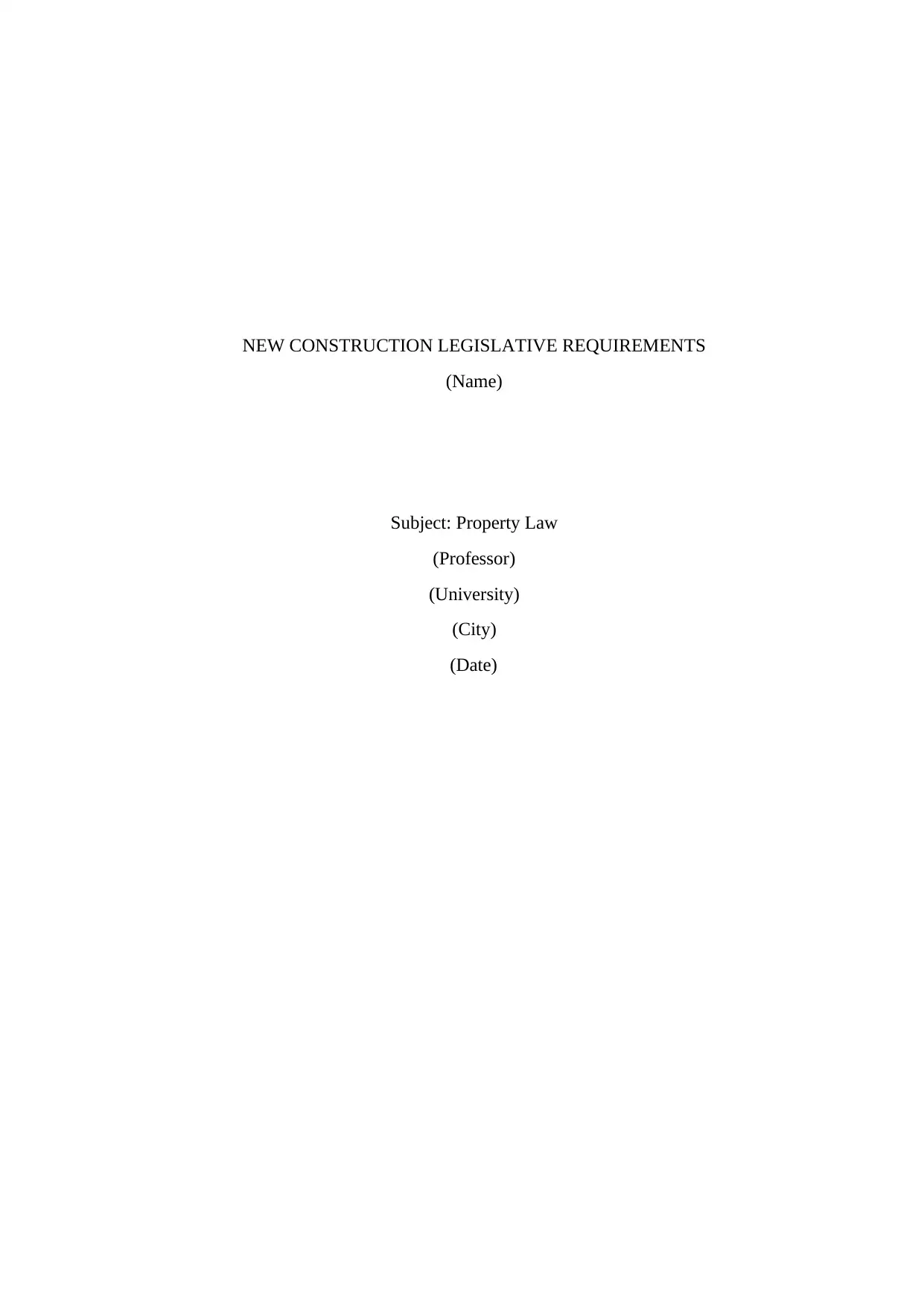
NEW CONSTRUCTION LEGISLATIVE REQUIREMENTS
(Name)
Subject: Property Law
(Professor)
(University)
(City)
(Date)
(Name)
Subject: Property Law
(Professor)
(University)
(City)
(Date)
Paraphrase This Document
Need a fresh take? Get an instant paraphrase of this document with our AI Paraphraser
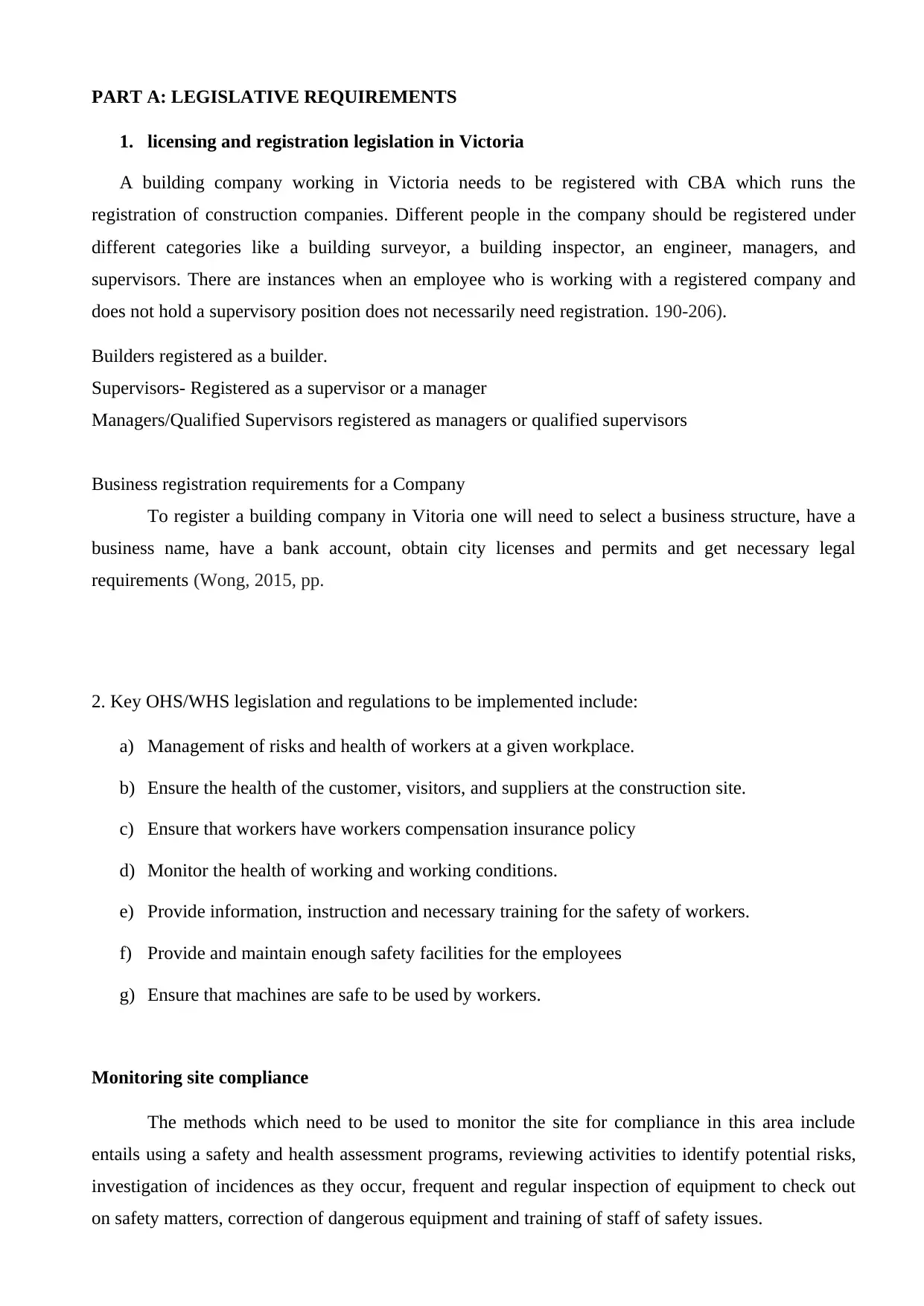
PART A: LEGISLATIVE REQUIREMENTS
1. licensing and registration legislation in Victoria
A building company working in Victoria needs to be registered with CBA which runs the
registration of construction companies. Different people in the company should be registered under
different categories like a building surveyor, a building inspector, an engineer, managers, and
supervisors. There are instances when an employee who is working with a registered company and
does not hold a supervisory position does not necessarily need registration. 190-206).
Builders registered as a builder.
Supervisors- Registered as a supervisor or a manager
Managers/Qualified Supervisors registered as managers or qualified supervisors
Business registration requirements for a Company
To register a building company in Vitoria one will need to select a business structure, have a
business name, have a bank account, obtain city licenses and permits and get necessary legal
requirements (Wong, 2015, pp.
2. Key OHS/WHS legislation and regulations to be implemented include:
a) Management of risks and health of workers at a given workplace.
b) Ensure the health of the customer, visitors, and suppliers at the construction site.
c) Ensure that workers have workers compensation insurance policy
d) Monitor the health of working and working conditions.
e) Provide information, instruction and necessary training for the safety of workers.
f) Provide and maintain enough safety facilities for the employees
g) Ensure that machines are safe to be used by workers.
Monitoring site compliance
The methods which need to be used to monitor the site for compliance in this area include
entails using a safety and health assessment programs, reviewing activities to identify potential risks,
investigation of incidences as they occur, frequent and regular inspection of equipment to check out
on safety matters, correction of dangerous equipment and training of staff of safety issues.
1. licensing and registration legislation in Victoria
A building company working in Victoria needs to be registered with CBA which runs the
registration of construction companies. Different people in the company should be registered under
different categories like a building surveyor, a building inspector, an engineer, managers, and
supervisors. There are instances when an employee who is working with a registered company and
does not hold a supervisory position does not necessarily need registration. 190-206).
Builders registered as a builder.
Supervisors- Registered as a supervisor or a manager
Managers/Qualified Supervisors registered as managers or qualified supervisors
Business registration requirements for a Company
To register a building company in Vitoria one will need to select a business structure, have a
business name, have a bank account, obtain city licenses and permits and get necessary legal
requirements (Wong, 2015, pp.
2. Key OHS/WHS legislation and regulations to be implemented include:
a) Management of risks and health of workers at a given workplace.
b) Ensure the health of the customer, visitors, and suppliers at the construction site.
c) Ensure that workers have workers compensation insurance policy
d) Monitor the health of working and working conditions.
e) Provide information, instruction and necessary training for the safety of workers.
f) Provide and maintain enough safety facilities for the employees
g) Ensure that machines are safe to be used by workers.
Monitoring site compliance
The methods which need to be used to monitor the site for compliance in this area include
entails using a safety and health assessment programs, reviewing activities to identify potential risks,
investigation of incidences as they occur, frequent and regular inspection of equipment to check out
on safety matters, correction of dangerous equipment and training of staff of safety issues.
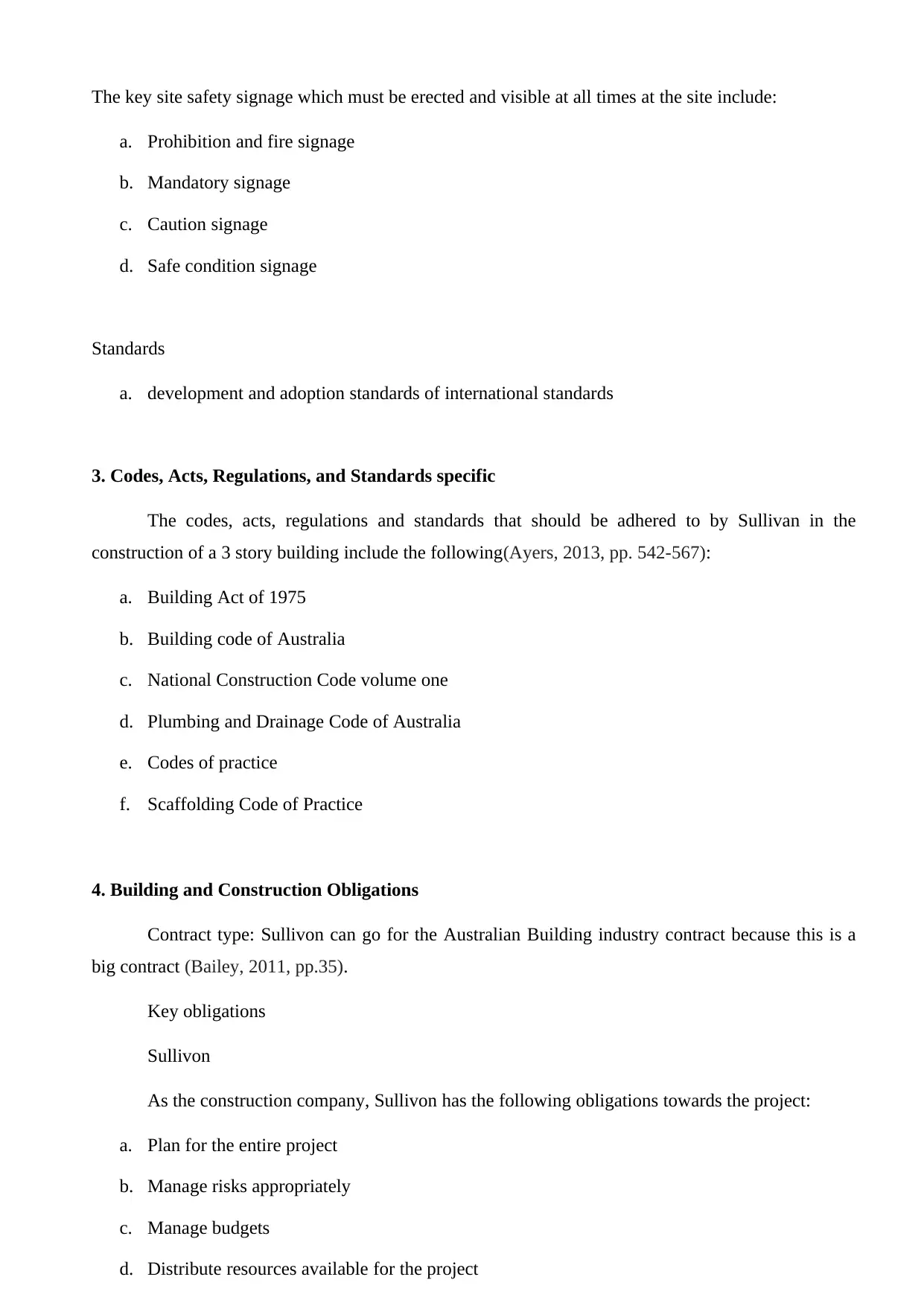
The key site safety signage which must be erected and visible at all times at the site include:
a. Prohibition and fire signage
b. Mandatory signage
c. Caution signage
d. Safe condition signage
Standards
a. development and adoption standards of international standards
3. Codes, Acts, Regulations, and Standards specific
The codes, acts, regulations and standards that should be adhered to by Sullivan in the
construction of a 3 story building include the following(Ayers, 2013, pp. 542-567):
a. Building Act of 1975
b. Building code of Australia
c. National Construction Code volume one
d. Plumbing and Drainage Code of Australia
e. Codes of practice
f. Scaffolding Code of Practice
4. Building and Construction Obligations
Contract type: Sullivon can go for the Australian Building industry contract because this is a
big contract (Bailey, 2011, pp.35).
Key obligations
Sullivon
As the construction company, Sullivon has the following obligations towards the project:
a. Plan for the entire project
b. Manage risks appropriately
c. Manage budgets
d. Distribute resources available for the project
a. Prohibition and fire signage
b. Mandatory signage
c. Caution signage
d. Safe condition signage
Standards
a. development and adoption standards of international standards
3. Codes, Acts, Regulations, and Standards specific
The codes, acts, regulations and standards that should be adhered to by Sullivan in the
construction of a 3 story building include the following(Ayers, 2013, pp. 542-567):
a. Building Act of 1975
b. Building code of Australia
c. National Construction Code volume one
d. Plumbing and Drainage Code of Australia
e. Codes of practice
f. Scaffolding Code of Practice
4. Building and Construction Obligations
Contract type: Sullivon can go for the Australian Building industry contract because this is a
big contract (Bailey, 2011, pp.35).
Key obligations
Sullivon
As the construction company, Sullivon has the following obligations towards the project:
a. Plan for the entire project
b. Manage risks appropriately
c. Manage budgets
d. Distribute resources available for the project
⊘ This is a preview!⊘
Do you want full access?
Subscribe today to unlock all pages.

Trusted by 1+ million students worldwide
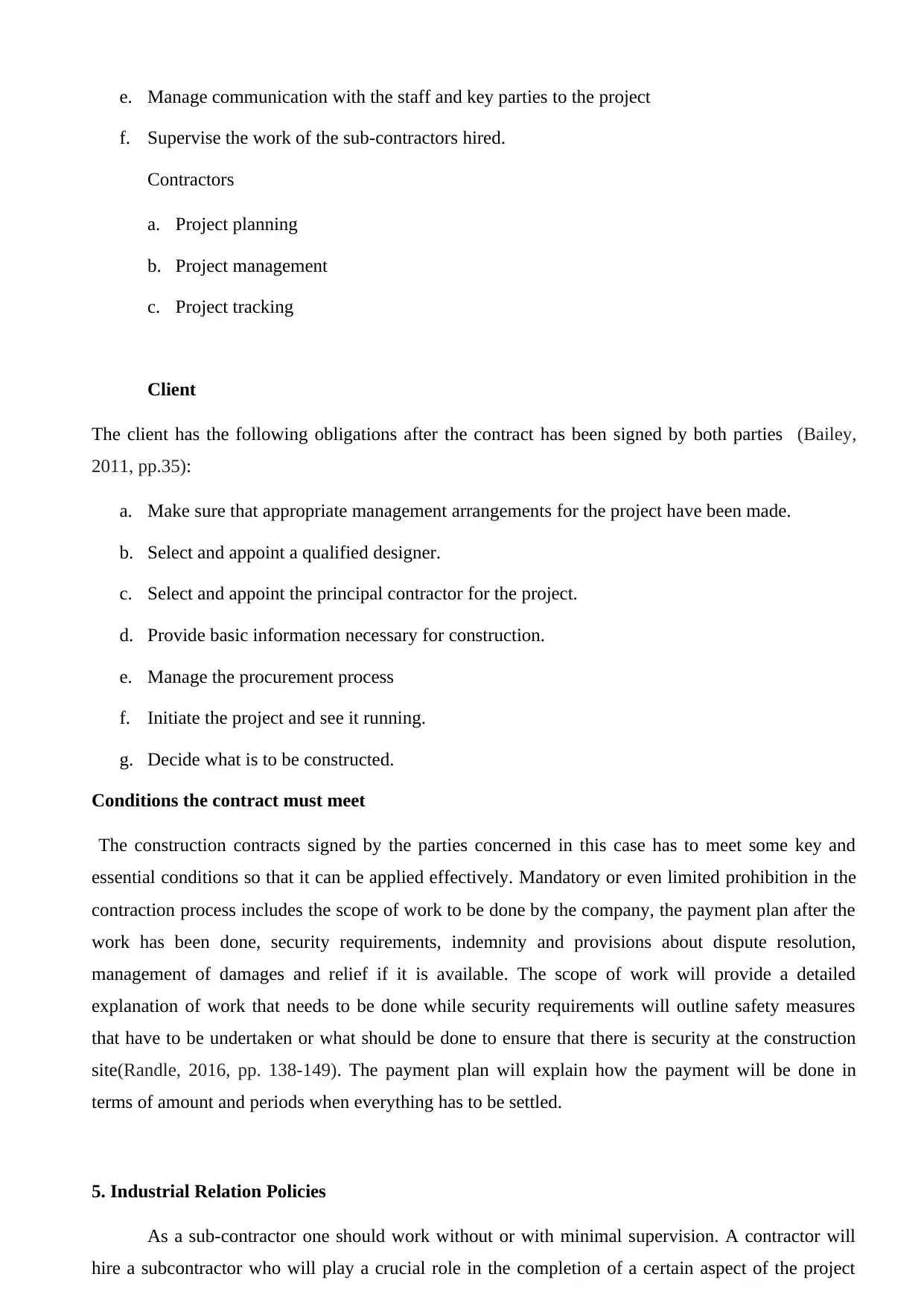
e. Manage communication with the staff and key parties to the project
f. Supervise the work of the sub-contractors hired.
Contractors
a. Project planning
b. Project management
c. Project tracking
Client
The client has the following obligations after the contract has been signed by both parties (Bailey,
2011, pp.35):
a. Make sure that appropriate management arrangements for the project have been made.
b. Select and appoint a qualified designer.
c. Select and appoint the principal contractor for the project.
d. Provide basic information necessary for construction.
e. Manage the procurement process
f. Initiate the project and see it running.
g. Decide what is to be constructed.
Conditions the contract must meet
The construction contracts signed by the parties concerned in this case has to meet some key and
essential conditions so that it can be applied effectively. Mandatory or even limited prohibition in the
contraction process includes the scope of work to be done by the company, the payment plan after the
work has been done, security requirements, indemnity and provisions about dispute resolution,
management of damages and relief if it is available. The scope of work will provide a detailed
explanation of work that needs to be done while security requirements will outline safety measures
that have to be undertaken or what should be done to ensure that there is security at the construction
site(Randle, 2016, pp. 138-149). The payment plan will explain how the payment will be done in
terms of amount and periods when everything has to be settled.
5. Industrial Relation Policies
As a sub-contractor one should work without or with minimal supervision. A contractor will
hire a subcontractor who will play a crucial role in the completion of a certain aspect of the project
f. Supervise the work of the sub-contractors hired.
Contractors
a. Project planning
b. Project management
c. Project tracking
Client
The client has the following obligations after the contract has been signed by both parties (Bailey,
2011, pp.35):
a. Make sure that appropriate management arrangements for the project have been made.
b. Select and appoint a qualified designer.
c. Select and appoint the principal contractor for the project.
d. Provide basic information necessary for construction.
e. Manage the procurement process
f. Initiate the project and see it running.
g. Decide what is to be constructed.
Conditions the contract must meet
The construction contracts signed by the parties concerned in this case has to meet some key and
essential conditions so that it can be applied effectively. Mandatory or even limited prohibition in the
contraction process includes the scope of work to be done by the company, the payment plan after the
work has been done, security requirements, indemnity and provisions about dispute resolution,
management of damages and relief if it is available. The scope of work will provide a detailed
explanation of work that needs to be done while security requirements will outline safety measures
that have to be undertaken or what should be done to ensure that there is security at the construction
site(Randle, 2016, pp. 138-149). The payment plan will explain how the payment will be done in
terms of amount and periods when everything has to be settled.
5. Industrial Relation Policies
As a sub-contractor one should work without or with minimal supervision. A contractor will
hire a subcontractor who will play a crucial role in the completion of a certain aspect of the project
Paraphrase This Document
Need a fresh take? Get an instant paraphrase of this document with our AI Paraphraser
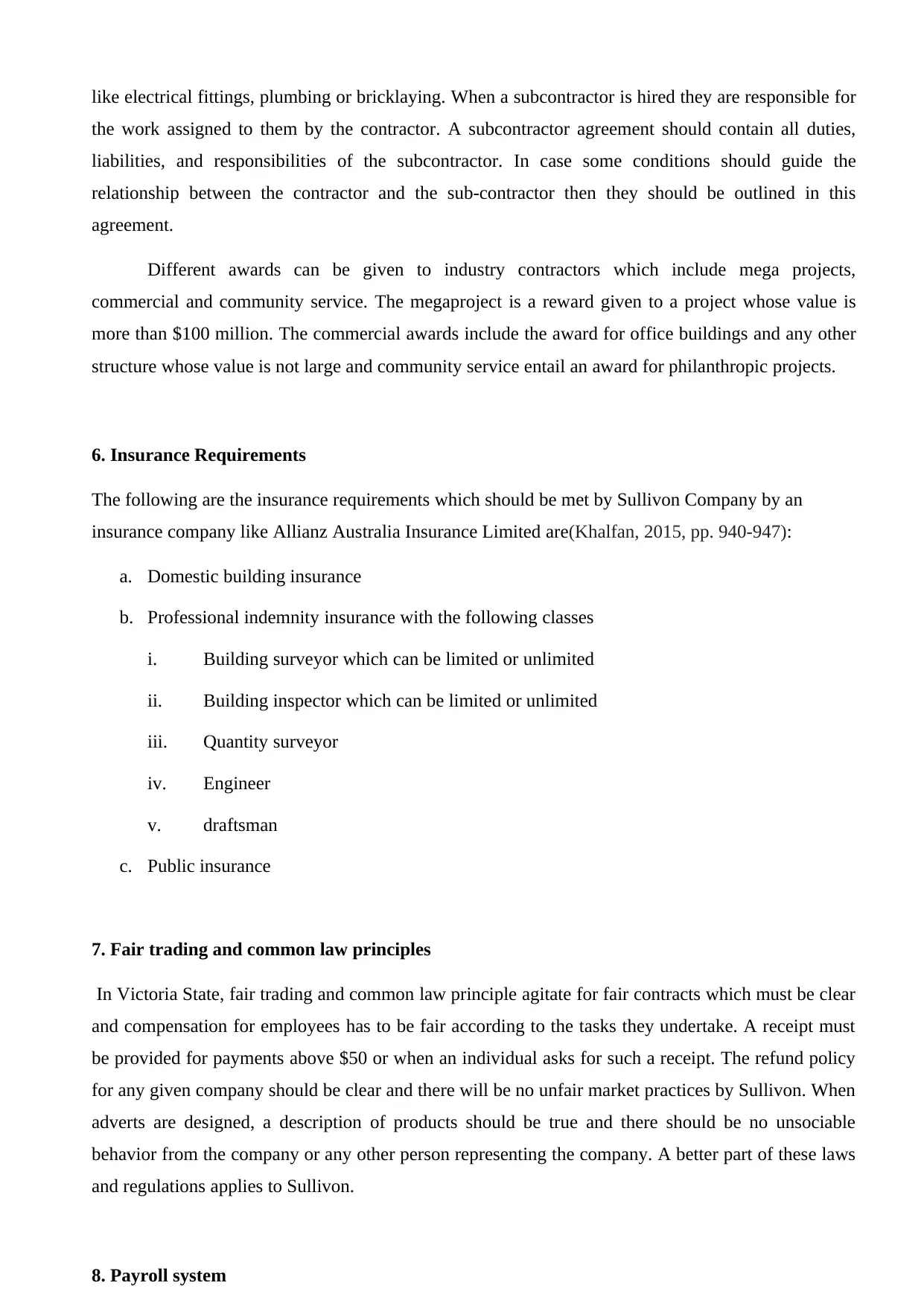
like electrical fittings, plumbing or bricklaying. When a subcontractor is hired they are responsible for
the work assigned to them by the contractor. A subcontractor agreement should contain all duties,
liabilities, and responsibilities of the subcontractor. In case some conditions should guide the
relationship between the contractor and the sub-contractor then they should be outlined in this
agreement.
Different awards can be given to industry contractors which include mega projects,
commercial and community service. The megaproject is a reward given to a project whose value is
more than $100 million. The commercial awards include the award for office buildings and any other
structure whose value is not large and community service entail an award for philanthropic projects.
6. Insurance Requirements
The following are the insurance requirements which should be met by Sullivon Company by an
insurance company like Allianz Australia Insurance Limited are(Khalfan, 2015, pp. 940-947):
a. Domestic building insurance
b. Professional indemnity insurance with the following classes
i. Building surveyor which can be limited or unlimited
ii. Building inspector which can be limited or unlimited
iii. Quantity surveyor
iv. Engineer
v. draftsman
c. Public insurance
7. Fair trading and common law principles
In Victoria State, fair trading and common law principle agitate for fair contracts which must be clear
and compensation for employees has to be fair according to the tasks they undertake. A receipt must
be provided for payments above $50 or when an individual asks for such a receipt. The refund policy
for any given company should be clear and there will be no unfair market practices by Sullivon. When
adverts are designed, a description of products should be true and there should be no unsociable
behavior from the company or any other person representing the company. A better part of these laws
and regulations applies to Sullivon.
8. Payroll system
the work assigned to them by the contractor. A subcontractor agreement should contain all duties,
liabilities, and responsibilities of the subcontractor. In case some conditions should guide the
relationship between the contractor and the sub-contractor then they should be outlined in this
agreement.
Different awards can be given to industry contractors which include mega projects,
commercial and community service. The megaproject is a reward given to a project whose value is
more than $100 million. The commercial awards include the award for office buildings and any other
structure whose value is not large and community service entail an award for philanthropic projects.
6. Insurance Requirements
The following are the insurance requirements which should be met by Sullivon Company by an
insurance company like Allianz Australia Insurance Limited are(Khalfan, 2015, pp. 940-947):
a. Domestic building insurance
b. Professional indemnity insurance with the following classes
i. Building surveyor which can be limited or unlimited
ii. Building inspector which can be limited or unlimited
iii. Quantity surveyor
iv. Engineer
v. draftsman
c. Public insurance
7. Fair trading and common law principles
In Victoria State, fair trading and common law principle agitate for fair contracts which must be clear
and compensation for employees has to be fair according to the tasks they undertake. A receipt must
be provided for payments above $50 or when an individual asks for such a receipt. The refund policy
for any given company should be clear and there will be no unfair market practices by Sullivon. When
adverts are designed, a description of products should be true and there should be no unsociable
behavior from the company or any other person representing the company. A better part of these laws
and regulations applies to Sullivon.
8. Payroll system
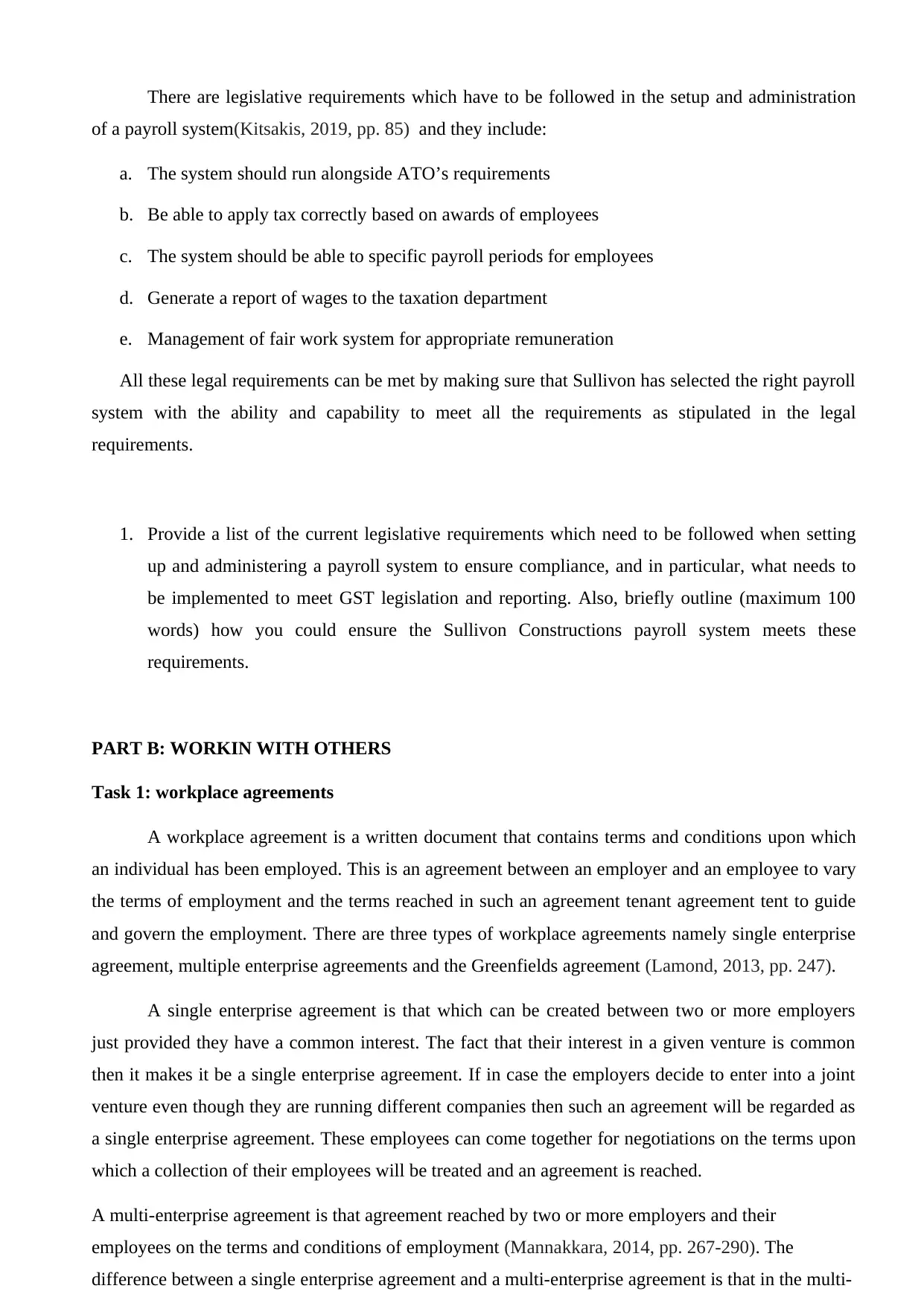
There are legislative requirements which have to be followed in the setup and administration
of a payroll system(Kitsakis, 2019, pp. 85) and they include:
a. The system should run alongside ATO’s requirements
b. Be able to apply tax correctly based on awards of employees
c. The system should be able to specific payroll periods for employees
d. Generate a report of wages to the taxation department
e. Management of fair work system for appropriate remuneration
All these legal requirements can be met by making sure that Sullivon has selected the right payroll
system with the ability and capability to meet all the requirements as stipulated in the legal
requirements.
1. Provide a list of the current legislative requirements which need to be followed when setting
up and administering a payroll system to ensure compliance, and in particular, what needs to
be implemented to meet GST legislation and reporting. Also, briefly outline (maximum 100
words) how you could ensure the Sullivon Constructions payroll system meets these
requirements.
PART B: WORKIN WITH OTHERS
Task 1: workplace agreements
A workplace agreement is a written document that contains terms and conditions upon which
an individual has been employed. This is an agreement between an employer and an employee to vary
the terms of employment and the terms reached in such an agreement tenant agreement tent to guide
and govern the employment. There are three types of workplace agreements namely single enterprise
agreement, multiple enterprise agreements and the Greenfields agreement (Lamond, 2013, pp. 247).
A single enterprise agreement is that which can be created between two or more employers
just provided they have a common interest. The fact that their interest in a given venture is common
then it makes it be a single enterprise agreement. If in case the employers decide to enter into a joint
venture even though they are running different companies then such an agreement will be regarded as
a single enterprise agreement. These employees can come together for negotiations on the terms upon
which a collection of their employees will be treated and an agreement is reached.
A multi-enterprise agreement is that agreement reached by two or more employers and their
employees on the terms and conditions of employment (Mannakkara, 2014, pp. 267-290). The
difference between a single enterprise agreement and a multi-enterprise agreement is that in the multi-
of a payroll system(Kitsakis, 2019, pp. 85) and they include:
a. The system should run alongside ATO’s requirements
b. Be able to apply tax correctly based on awards of employees
c. The system should be able to specific payroll periods for employees
d. Generate a report of wages to the taxation department
e. Management of fair work system for appropriate remuneration
All these legal requirements can be met by making sure that Sullivon has selected the right payroll
system with the ability and capability to meet all the requirements as stipulated in the legal
requirements.
1. Provide a list of the current legislative requirements which need to be followed when setting
up and administering a payroll system to ensure compliance, and in particular, what needs to
be implemented to meet GST legislation and reporting. Also, briefly outline (maximum 100
words) how you could ensure the Sullivon Constructions payroll system meets these
requirements.
PART B: WORKIN WITH OTHERS
Task 1: workplace agreements
A workplace agreement is a written document that contains terms and conditions upon which
an individual has been employed. This is an agreement between an employer and an employee to vary
the terms of employment and the terms reached in such an agreement tenant agreement tent to guide
and govern the employment. There are three types of workplace agreements namely single enterprise
agreement, multiple enterprise agreements and the Greenfields agreement (Lamond, 2013, pp. 247).
A single enterprise agreement is that which can be created between two or more employers
just provided they have a common interest. The fact that their interest in a given venture is common
then it makes it be a single enterprise agreement. If in case the employers decide to enter into a joint
venture even though they are running different companies then such an agreement will be regarded as
a single enterprise agreement. These employees can come together for negotiations on the terms upon
which a collection of their employees will be treated and an agreement is reached.
A multi-enterprise agreement is that agreement reached by two or more employers and their
employees on the terms and conditions of employment (Mannakkara, 2014, pp. 267-290). The
difference between a single enterprise agreement and a multi-enterprise agreement is that in the multi-
⊘ This is a preview!⊘
Do you want full access?
Subscribe today to unlock all pages.

Trusted by 1+ million students worldwide
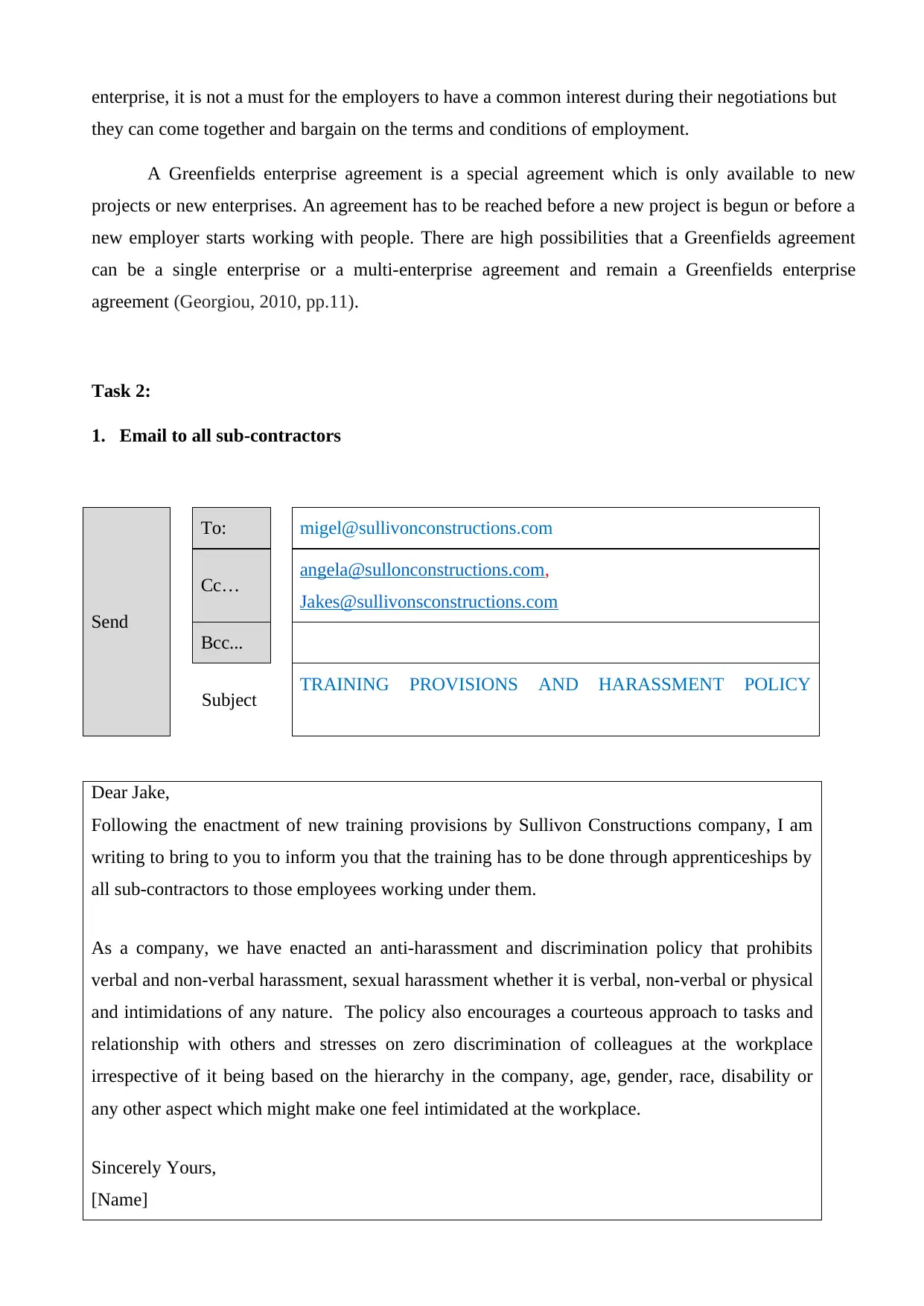
enterprise, it is not a must for the employers to have a common interest during their negotiations but
they can come together and bargain on the terms and conditions of employment.
A Greenfields enterprise agreement is a special agreement which is only available to new
projects or new enterprises. An agreement has to be reached before a new project is begun or before a
new employer starts working with people. There are high possibilities that a Greenfields agreement
can be a single enterprise or a multi-enterprise agreement and remain a Greenfields enterprise
agreement (Georgiou, 2010, pp.11).
Task 2:
1. Email to all sub-contractors
Send
To: migel@sullivonconstructions.com
Cc… angela@sullonconstructions.com,
Jakes@sullivonsconstructions.com
Bcc...
Subject TRAINING PROVISIONS AND HARASSMENT POLICY
Dear Jake,
Following the enactment of new training provisions by Sullivon Constructions company, I am
writing to bring to you to inform you that the training has to be done through apprenticeships by
all sub-contractors to those employees working under them.
As a company, we have enacted an anti-harassment and discrimination policy that prohibits
verbal and non-verbal harassment, sexual harassment whether it is verbal, non-verbal or physical
and intimidations of any nature. The policy also encourages a courteous approach to tasks and
relationship with others and stresses on zero discrimination of colleagues at the workplace
irrespective of it being based on the hierarchy in the company, age, gender, race, disability or
any other aspect which might make one feel intimidated at the workplace.
Sincerely Yours,
[Name]
they can come together and bargain on the terms and conditions of employment.
A Greenfields enterprise agreement is a special agreement which is only available to new
projects or new enterprises. An agreement has to be reached before a new project is begun or before a
new employer starts working with people. There are high possibilities that a Greenfields agreement
can be a single enterprise or a multi-enterprise agreement and remain a Greenfields enterprise
agreement (Georgiou, 2010, pp.11).
Task 2:
1. Email to all sub-contractors
Send
To: migel@sullivonconstructions.com
Cc… angela@sullonconstructions.com,
Jakes@sullivonsconstructions.com
Bcc...
Subject TRAINING PROVISIONS AND HARASSMENT POLICY
Dear Jake,
Following the enactment of new training provisions by Sullivon Constructions company, I am
writing to bring to you to inform you that the training has to be done through apprenticeships by
all sub-contractors to those employees working under them.
As a company, we have enacted an anti-harassment and discrimination policy that prohibits
verbal and non-verbal harassment, sexual harassment whether it is verbal, non-verbal or physical
and intimidations of any nature. The policy also encourages a courteous approach to tasks and
relationship with others and stresses on zero discrimination of colleagues at the workplace
irrespective of it being based on the hierarchy in the company, age, gender, race, disability or
any other aspect which might make one feel intimidated at the workplace.
Sincerely Yours,
[Name]
Paraphrase This Document
Need a fresh take? Get an instant paraphrase of this document with our AI Paraphraser
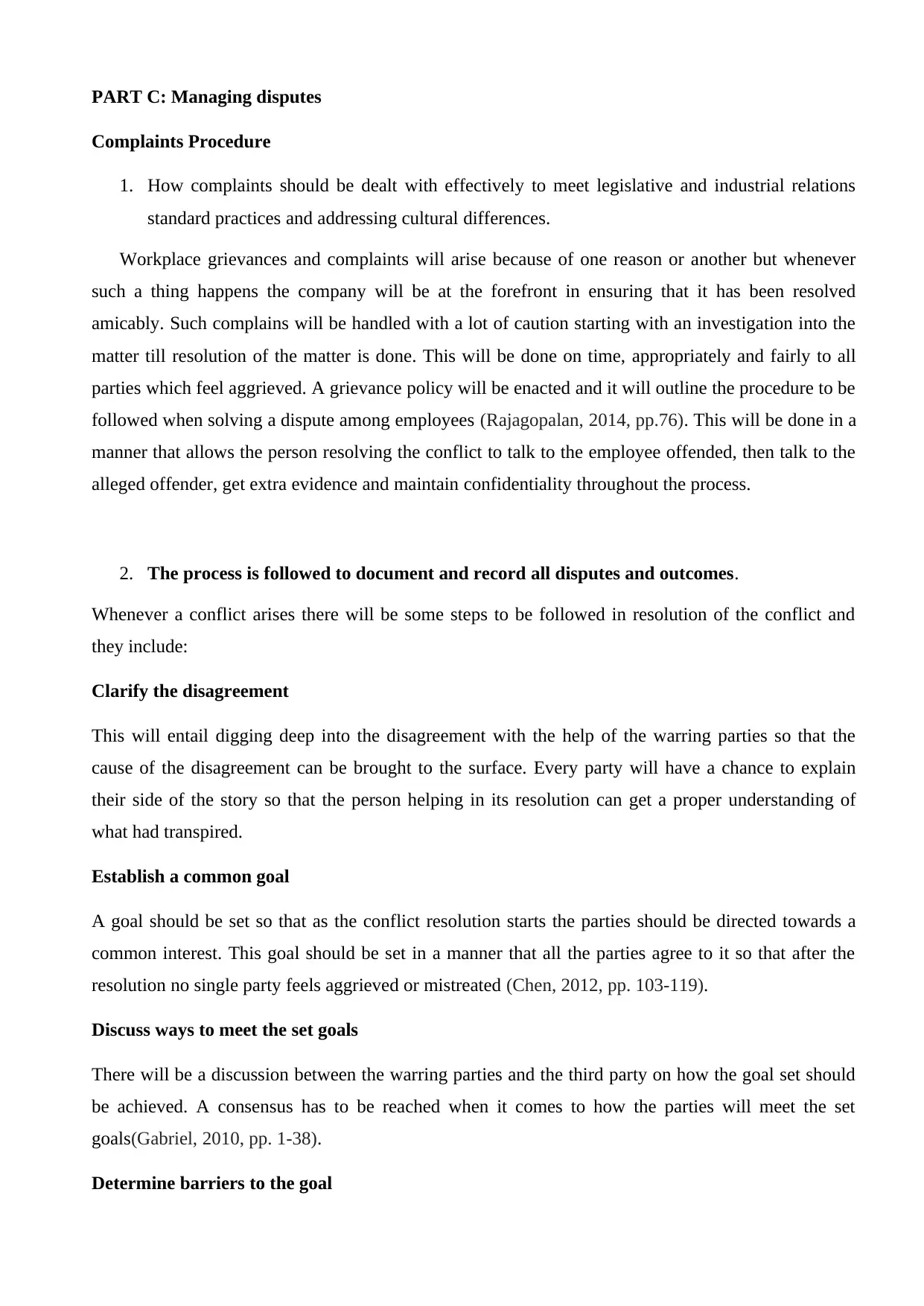
PART C: Managing disputes
Complaints Procedure
1. How complaints should be dealt with effectively to meet legislative and industrial relations
standard practices and addressing cultural differences.
Workplace grievances and complaints will arise because of one reason or another but whenever
such a thing happens the company will be at the forefront in ensuring that it has been resolved
amicably. Such complains will be handled with a lot of caution starting with an investigation into the
matter till resolution of the matter is done. This will be done on time, appropriately and fairly to all
parties which feel aggrieved. A grievance policy will be enacted and it will outline the procedure to be
followed when solving a dispute among employees (Rajagopalan, 2014, pp.76). This will be done in a
manner that allows the person resolving the conflict to talk to the employee offended, then talk to the
alleged offender, get extra evidence and maintain confidentiality throughout the process.
2. The process is followed to document and record all disputes and outcomes.
Whenever a conflict arises there will be some steps to be followed in resolution of the conflict and
they include:
Clarify the disagreement
This will entail digging deep into the disagreement with the help of the warring parties so that the
cause of the disagreement can be brought to the surface. Every party will have a chance to explain
their side of the story so that the person helping in its resolution can get a proper understanding of
what had transpired.
Establish a common goal
A goal should be set so that as the conflict resolution starts the parties should be directed towards a
common interest. This goal should be set in a manner that all the parties agree to it so that after the
resolution no single party feels aggrieved or mistreated (Chen, 2012, pp. 103-119).
Discuss ways to meet the set goals
There will be a discussion between the warring parties and the third party on how the goal set should
be achieved. A consensus has to be reached when it comes to how the parties will meet the set
goals(Gabriel, 2010, pp. 1-38).
Determine barriers to the goal
Complaints Procedure
1. How complaints should be dealt with effectively to meet legislative and industrial relations
standard practices and addressing cultural differences.
Workplace grievances and complaints will arise because of one reason or another but whenever
such a thing happens the company will be at the forefront in ensuring that it has been resolved
amicably. Such complains will be handled with a lot of caution starting with an investigation into the
matter till resolution of the matter is done. This will be done on time, appropriately and fairly to all
parties which feel aggrieved. A grievance policy will be enacted and it will outline the procedure to be
followed when solving a dispute among employees (Rajagopalan, 2014, pp.76). This will be done in a
manner that allows the person resolving the conflict to talk to the employee offended, then talk to the
alleged offender, get extra evidence and maintain confidentiality throughout the process.
2. The process is followed to document and record all disputes and outcomes.
Whenever a conflict arises there will be some steps to be followed in resolution of the conflict and
they include:
Clarify the disagreement
This will entail digging deep into the disagreement with the help of the warring parties so that the
cause of the disagreement can be brought to the surface. Every party will have a chance to explain
their side of the story so that the person helping in its resolution can get a proper understanding of
what had transpired.
Establish a common goal
A goal should be set so that as the conflict resolution starts the parties should be directed towards a
common interest. This goal should be set in a manner that all the parties agree to it so that after the
resolution no single party feels aggrieved or mistreated (Chen, 2012, pp. 103-119).
Discuss ways to meet the set goals
There will be a discussion between the warring parties and the third party on how the goal set should
be achieved. A consensus has to be reached when it comes to how the parties will meet the set
goals(Gabriel, 2010, pp. 1-38).
Determine barriers to the goal
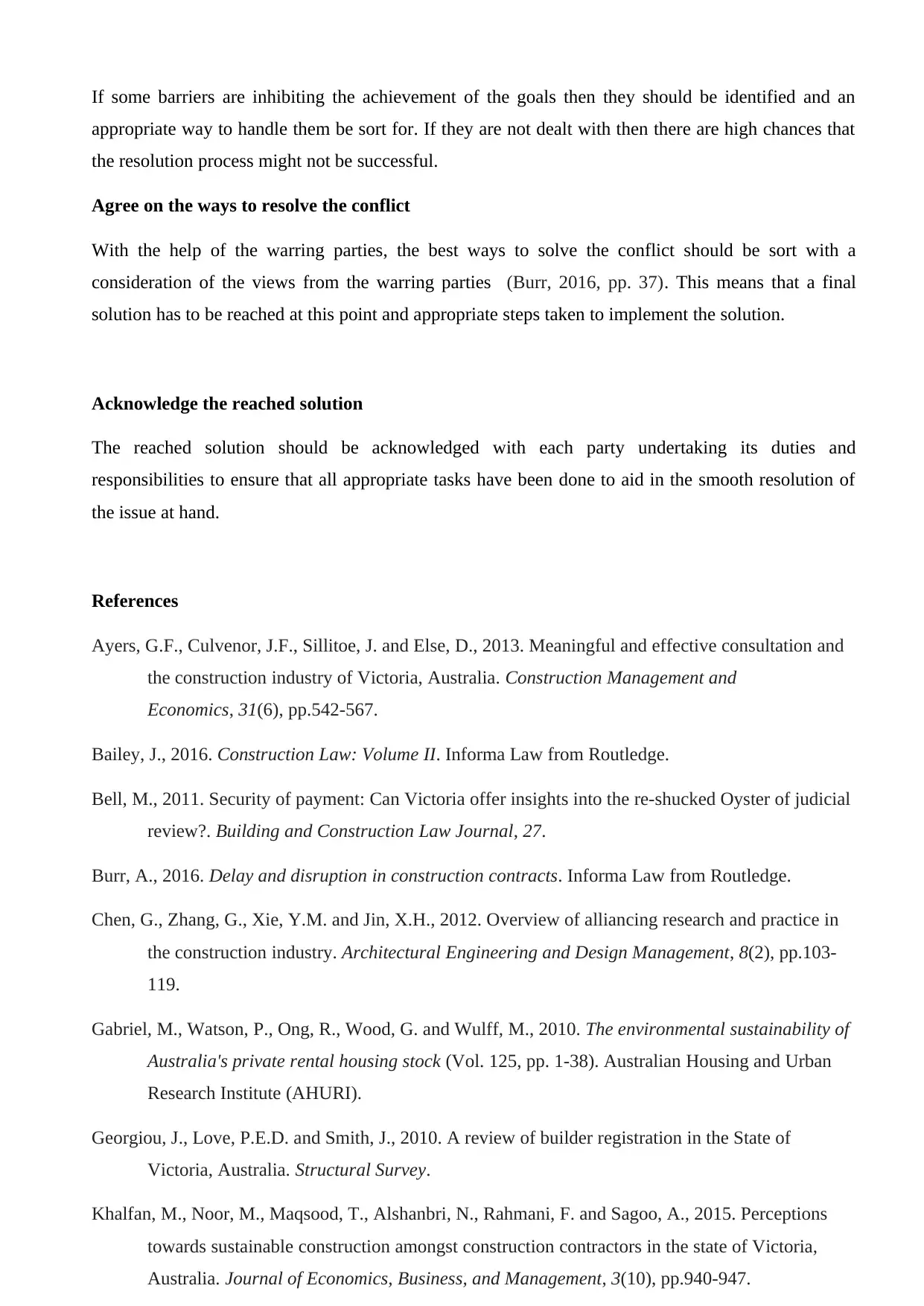
If some barriers are inhibiting the achievement of the goals then they should be identified and an
appropriate way to handle them be sort for. If they are not dealt with then there are high chances that
the resolution process might not be successful.
Agree on the ways to resolve the conflict
With the help of the warring parties, the best ways to solve the conflict should be sort with a
consideration of the views from the warring parties (Burr, 2016, pp. 37). This means that a final
solution has to be reached at this point and appropriate steps taken to implement the solution.
Acknowledge the reached solution
The reached solution should be acknowledged with each party undertaking its duties and
responsibilities to ensure that all appropriate tasks have been done to aid in the smooth resolution of
the issue at hand.
References
Ayers, G.F., Culvenor, J.F., Sillitoe, J. and Else, D., 2013. Meaningful and effective consultation and
the construction industry of Victoria, Australia. Construction Management and
Economics, 31(6), pp.542-567.
Bailey, J., 2016. Construction Law: Volume II. Informa Law from Routledge.
Bell, M., 2011. Security of payment: Can Victoria offer insights into the re-shucked Oyster of judicial
review?. Building and Construction Law Journal, 27.
Burr, A., 2016. Delay and disruption in construction contracts. Informa Law from Routledge.
Chen, G., Zhang, G., Xie, Y.M. and Jin, X.H., 2012. Overview of alliancing research and practice in
the construction industry. Architectural Engineering and Design Management, 8(2), pp.103-
119.
Gabriel, M., Watson, P., Ong, R., Wood, G. and Wulff, M., 2010. The environmental sustainability of
Australia's private rental housing stock (Vol. 125, pp. 1-38). Australian Housing and Urban
Research Institute (AHURI).
Georgiou, J., Love, P.E.D. and Smith, J., 2010. A review of builder registration in the State of
Victoria, Australia. Structural Survey.
Khalfan, M., Noor, M., Maqsood, T., Alshanbri, N., Rahmani, F. and Sagoo, A., 2015. Perceptions
towards sustainable construction amongst construction contractors in the state of Victoria,
Australia. Journal of Economics, Business, and Management, 3(10), pp.940-947.
appropriate way to handle them be sort for. If they are not dealt with then there are high chances that
the resolution process might not be successful.
Agree on the ways to resolve the conflict
With the help of the warring parties, the best ways to solve the conflict should be sort with a
consideration of the views from the warring parties (Burr, 2016, pp. 37). This means that a final
solution has to be reached at this point and appropriate steps taken to implement the solution.
Acknowledge the reached solution
The reached solution should be acknowledged with each party undertaking its duties and
responsibilities to ensure that all appropriate tasks have been done to aid in the smooth resolution of
the issue at hand.
References
Ayers, G.F., Culvenor, J.F., Sillitoe, J. and Else, D., 2013. Meaningful and effective consultation and
the construction industry of Victoria, Australia. Construction Management and
Economics, 31(6), pp.542-567.
Bailey, J., 2016. Construction Law: Volume II. Informa Law from Routledge.
Bell, M., 2011. Security of payment: Can Victoria offer insights into the re-shucked Oyster of judicial
review?. Building and Construction Law Journal, 27.
Burr, A., 2016. Delay and disruption in construction contracts. Informa Law from Routledge.
Chen, G., Zhang, G., Xie, Y.M. and Jin, X.H., 2012. Overview of alliancing research and practice in
the construction industry. Architectural Engineering and Design Management, 8(2), pp.103-
119.
Gabriel, M., Watson, P., Ong, R., Wood, G. and Wulff, M., 2010. The environmental sustainability of
Australia's private rental housing stock (Vol. 125, pp. 1-38). Australian Housing and Urban
Research Institute (AHURI).
Georgiou, J., Love, P.E.D. and Smith, J., 2010. A review of builder registration in the State of
Victoria, Australia. Structural Survey.
Khalfan, M., Noor, M., Maqsood, T., Alshanbri, N., Rahmani, F. and Sagoo, A., 2015. Perceptions
towards sustainable construction amongst construction contractors in the state of Victoria,
Australia. Journal of Economics, Business, and Management, 3(10), pp.940-947.
⊘ This is a preview!⊘
Do you want full access?
Subscribe today to unlock all pages.

Trusted by 1+ million students worldwide
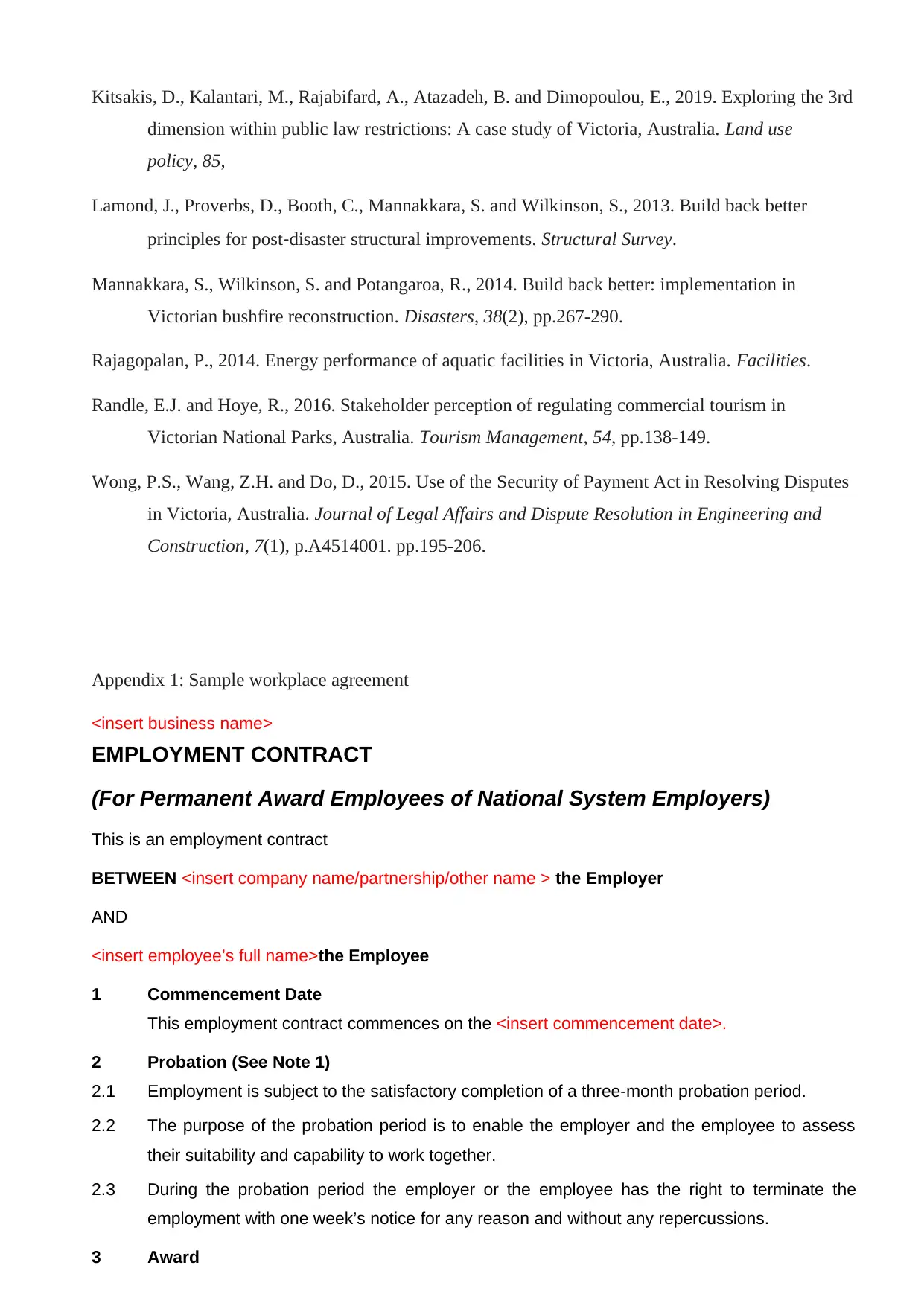
Kitsakis, D., Kalantari, M., Rajabifard, A., Atazadeh, B. and Dimopoulou, E., 2019. Exploring the 3rd
dimension within public law restrictions: A case study of Victoria, Australia. Land use
policy, 85,
Lamond, J., Proverbs, D., Booth, C., Mannakkara, S. and Wilkinson, S., 2013. Build back better
principles for post‐disaster structural improvements. Structural Survey.
Mannakkara, S., Wilkinson, S. and Potangaroa, R., 2014. Build back better: implementation in
Victorian bushfire reconstruction. Disasters, 38(2), pp.267-290.
Rajagopalan, P., 2014. Energy performance of aquatic facilities in Victoria, Australia. Facilities.
Randle, E.J. and Hoye, R., 2016. Stakeholder perception of regulating commercial tourism in
Victorian National Parks, Australia. Tourism Management, 54, pp.138-149.
Wong, P.S., Wang, Z.H. and Do, D., 2015. Use of the Security of Payment Act in Resolving Disputes
in Victoria, Australia. Journal of Legal Affairs and Dispute Resolution in Engineering and
Construction, 7(1), p.A4514001. pp.195-206.
Appendix 1: Sample workplace agreement
<insert business name>
EMPLOYMENT CONTRACT
(For Permanent Award Employees of National System Employers)
This is an employment contract
BETWEEN <insert company name/partnership/other name > the Employer
AND
<insert employee’s full name>the Employee
1 Commencement Date
This employment contract commences on the <insert commencement date>.
2 Probation (See Note 1)
2.1 Employment is subject to the satisfactory completion of a three-month probation period.
2.2 The purpose of the probation period is to enable the employer and the employee to assess
their suitability and capability to work together.
2.3 During the probation period the employer or the employee has the right to terminate the
employment with one week’s notice for any reason and without any repercussions.
3 Award
dimension within public law restrictions: A case study of Victoria, Australia. Land use
policy, 85,
Lamond, J., Proverbs, D., Booth, C., Mannakkara, S. and Wilkinson, S., 2013. Build back better
principles for post‐disaster structural improvements. Structural Survey.
Mannakkara, S., Wilkinson, S. and Potangaroa, R., 2014. Build back better: implementation in
Victorian bushfire reconstruction. Disasters, 38(2), pp.267-290.
Rajagopalan, P., 2014. Energy performance of aquatic facilities in Victoria, Australia. Facilities.
Randle, E.J. and Hoye, R., 2016. Stakeholder perception of regulating commercial tourism in
Victorian National Parks, Australia. Tourism Management, 54, pp.138-149.
Wong, P.S., Wang, Z.H. and Do, D., 2015. Use of the Security of Payment Act in Resolving Disputes
in Victoria, Australia. Journal of Legal Affairs and Dispute Resolution in Engineering and
Construction, 7(1), p.A4514001. pp.195-206.
Appendix 1: Sample workplace agreement
<insert business name>
EMPLOYMENT CONTRACT
(For Permanent Award Employees of National System Employers)
This is an employment contract
BETWEEN <insert company name/partnership/other name > the Employer
AND
<insert employee’s full name>the Employee
1 Commencement Date
This employment contract commences on the <insert commencement date>.
2 Probation (See Note 1)
2.1 Employment is subject to the satisfactory completion of a three-month probation period.
2.2 The purpose of the probation period is to enable the employer and the employee to assess
their suitability and capability to work together.
2.3 During the probation period the employer or the employee has the right to terminate the
employment with one week’s notice for any reason and without any repercussions.
3 Award
Paraphrase This Document
Need a fresh take? Get an instant paraphrase of this document with our AI Paraphraser
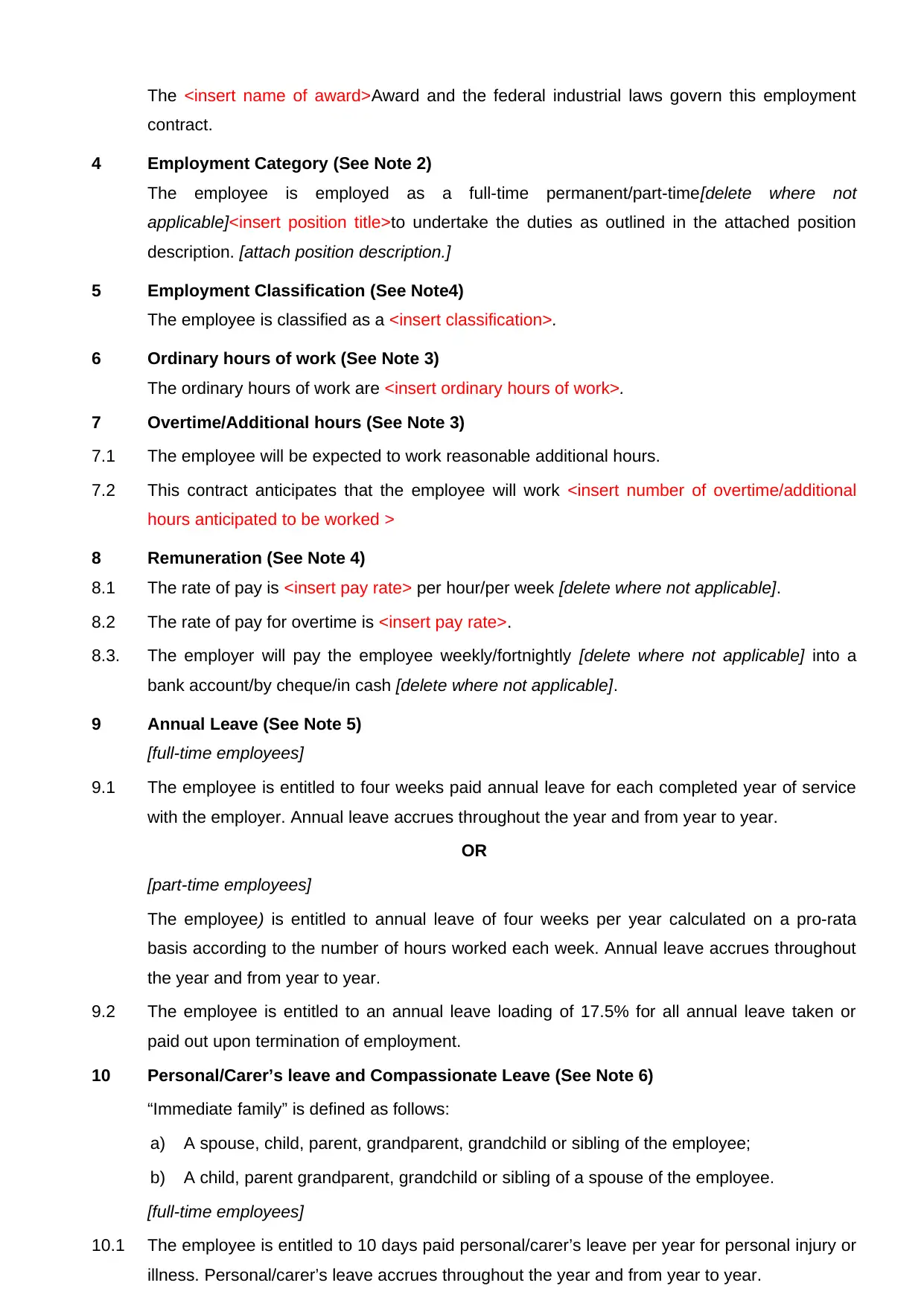
The <insert name of award>Award and the federal industrial laws govern this employment
contract.
4 Employment Category (See Note 2)
The employee is employed as a full-time permanent/part-time[delete where not
applicable]<insert position title>to undertake the duties as outlined in the attached position
description. [attach position description.]
5 Employment Classification (See Note4)
The employee is classified as a <insert classification>.
6 Ordinary hours of work (See Note 3)
The ordinary hours of work are <insert ordinary hours of work>.
7 Overtime/Additional hours (See Note 3)
7.1 The employee will be expected to work reasonable additional hours.
7.2 This contract anticipates that the employee will work <insert number of overtime/additional
hours anticipated to be worked >
8 Remuneration (See Note 4)
8.1 The rate of pay is <insert pay rate> per hour/per week [delete where not applicable].
8.2 The rate of pay for overtime is <insert pay rate>.
8.3. The employer will pay the employee weekly/fortnightly [delete where not applicable] into a
bank account/by cheque/in cash [delete where not applicable].
9 Annual Leave (See Note 5)
[full-time employees]
9.1 The employee is entitled to four weeks paid annual leave for each completed year of service
with the employer. Annual leave accrues throughout the year and from year to year.
OR
[part-time employees]
The employee) is entitled to annual leave of four weeks per year calculated on a pro-rata
basis according to the number of hours worked each week. Annual leave accrues throughout
the year and from year to year.
9.2 The employee is entitled to an annual leave loading of 17.5% for all annual leave taken or
paid out upon termination of employment.
10 Personal/Carer’s leave and Compassionate Leave (See Note 6)
“Immediate family” is defined as follows:
a) A spouse, child, parent, grandparent, grandchild or sibling of the employee;
b) A child, parent grandparent, grandchild or sibling of a spouse of the employee.
[full-time employees]
10.1 The employee is entitled to 10 days paid personal/carer’s leave per year for personal injury or
illness. Personal/carer’s leave accrues throughout the year and from year to year.
contract.
4 Employment Category (See Note 2)
The employee is employed as a full-time permanent/part-time[delete where not
applicable]<insert position title>to undertake the duties as outlined in the attached position
description. [attach position description.]
5 Employment Classification (See Note4)
The employee is classified as a <insert classification>.
6 Ordinary hours of work (See Note 3)
The ordinary hours of work are <insert ordinary hours of work>.
7 Overtime/Additional hours (See Note 3)
7.1 The employee will be expected to work reasonable additional hours.
7.2 This contract anticipates that the employee will work <insert number of overtime/additional
hours anticipated to be worked >
8 Remuneration (See Note 4)
8.1 The rate of pay is <insert pay rate> per hour/per week [delete where not applicable].
8.2 The rate of pay for overtime is <insert pay rate>.
8.3. The employer will pay the employee weekly/fortnightly [delete where not applicable] into a
bank account/by cheque/in cash [delete where not applicable].
9 Annual Leave (See Note 5)
[full-time employees]
9.1 The employee is entitled to four weeks paid annual leave for each completed year of service
with the employer. Annual leave accrues throughout the year and from year to year.
OR
[part-time employees]
The employee) is entitled to annual leave of four weeks per year calculated on a pro-rata
basis according to the number of hours worked each week. Annual leave accrues throughout
the year and from year to year.
9.2 The employee is entitled to an annual leave loading of 17.5% for all annual leave taken or
paid out upon termination of employment.
10 Personal/Carer’s leave and Compassionate Leave (See Note 6)
“Immediate family” is defined as follows:
a) A spouse, child, parent, grandparent, grandchild or sibling of the employee;
b) A child, parent grandparent, grandchild or sibling of a spouse of the employee.
[full-time employees]
10.1 The employee is entitled to 10 days paid personal/carer’s leave per year for personal injury or
illness. Personal/carer’s leave accrues throughout the year and from year to year.
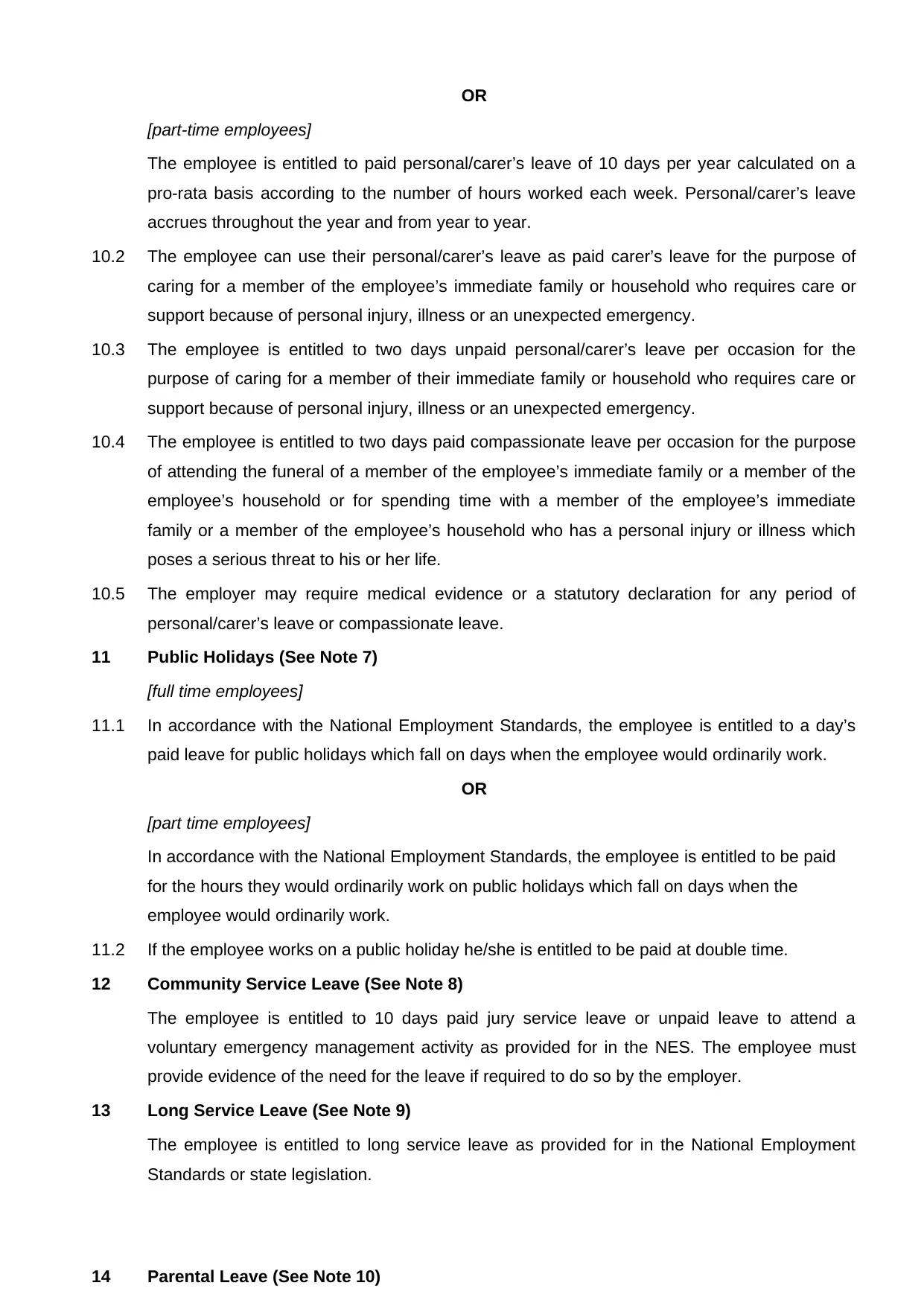
OR
[part-time employees]
The employee is entitled to paid personal/carer’s leave of 10 days per year calculated on a
pro-rata basis according to the number of hours worked each week. Personal/carer’s leave
accrues throughout the year and from year to year.
10.2 The employee can use their personal/carer’s leave as paid carer’s leave for the purpose of
caring for a member of the employee’s immediate family or household who requires care or
support because of personal injury, illness or an unexpected emergency.
10.3 The employee is entitled to two days unpaid personal/carer’s leave per occasion for the
purpose of caring for a member of their immediate family or household who requires care or
support because of personal injury, illness or an unexpected emergency.
10.4 The employee is entitled to two days paid compassionate leave per occasion for the purpose
of attending the funeral of a member of the employee’s immediate family or a member of the
employee’s household or for spending time with a member of the employee’s immediate
family or a member of the employee’s household who has a personal injury or illness which
poses a serious threat to his or her life.
10.5 The employer may require medical evidence or a statutory declaration for any period of
personal/carer’s leave or compassionate leave.
11 Public Holidays (See Note 7)
[full time employees]
11.1 In accordance with the National Employment Standards, the employee is entitled to a day’s
paid leave for public holidays which fall on days when the employee would ordinarily work.
OR
[part time employees]
In accordance with the National Employment Standards, the employee is entitled to be paid
for the hours they would ordinarily work on public holidays which fall on days when the
employee would ordinarily work.
11.2 If the employee works on a public holiday he/she is entitled to be paid at double time.
12 Community Service Leave (See Note 8)
The employee is entitled to 10 days paid jury service leave or unpaid leave to attend a
voluntary emergency management activity as provided for in the NES. The employee must
provide evidence of the need for the leave if required to do so by the employer.
13 Long Service Leave (See Note 9)
The employee is entitled to long service leave as provided for in the National Employment
Standards or state legislation.
14 Parental Leave (See Note 10)
[part-time employees]
The employee is entitled to paid personal/carer’s leave of 10 days per year calculated on a
pro-rata basis according to the number of hours worked each week. Personal/carer’s leave
accrues throughout the year and from year to year.
10.2 The employee can use their personal/carer’s leave as paid carer’s leave for the purpose of
caring for a member of the employee’s immediate family or household who requires care or
support because of personal injury, illness or an unexpected emergency.
10.3 The employee is entitled to two days unpaid personal/carer’s leave per occasion for the
purpose of caring for a member of their immediate family or household who requires care or
support because of personal injury, illness or an unexpected emergency.
10.4 The employee is entitled to two days paid compassionate leave per occasion for the purpose
of attending the funeral of a member of the employee’s immediate family or a member of the
employee’s household or for spending time with a member of the employee’s immediate
family or a member of the employee’s household who has a personal injury or illness which
poses a serious threat to his or her life.
10.5 The employer may require medical evidence or a statutory declaration for any period of
personal/carer’s leave or compassionate leave.
11 Public Holidays (See Note 7)
[full time employees]
11.1 In accordance with the National Employment Standards, the employee is entitled to a day’s
paid leave for public holidays which fall on days when the employee would ordinarily work.
OR
[part time employees]
In accordance with the National Employment Standards, the employee is entitled to be paid
for the hours they would ordinarily work on public holidays which fall on days when the
employee would ordinarily work.
11.2 If the employee works on a public holiday he/she is entitled to be paid at double time.
12 Community Service Leave (See Note 8)
The employee is entitled to 10 days paid jury service leave or unpaid leave to attend a
voluntary emergency management activity as provided for in the NES. The employee must
provide evidence of the need for the leave if required to do so by the employer.
13 Long Service Leave (See Note 9)
The employee is entitled to long service leave as provided for in the National Employment
Standards or state legislation.
14 Parental Leave (See Note 10)
⊘ This is a preview!⊘
Do you want full access?
Subscribe today to unlock all pages.

Trusted by 1+ million students worldwide
1 out of 30
Related Documents
Your All-in-One AI-Powered Toolkit for Academic Success.
+13062052269
info@desklib.com
Available 24*7 on WhatsApp / Email
![[object Object]](/_next/static/media/star-bottom.7253800d.svg)
Unlock your academic potential
Copyright © 2020–2025 A2Z Services. All Rights Reserved. Developed and managed by ZUCOL.




